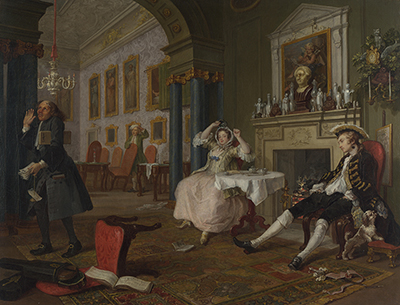William Hogarth's The Tête à Tête is the second painting in the six-part Marriage A-la-Mode. The series shows the tragic consequences of choosing to marry for money. The story focuses on two fathers, one an extravagant nobleman who is short on money and a wealthy merchant looking to buy his way into the aristocracy.
The series is held by The National Gallery in London. Painted in 1743, the series was Hogarth’s first to satirise the upper classes. It was also offered as uncoloured, reversed engravings for a guinea. The popularity of the moralising series helped Hogarth reach a wider audience. An oil on canvas, The Tête à Tête measures 69.9 by 90.8 centimetres (27.5 by 35.7 inches). The Viscount is seated on the right and his wife is across from him. The Methodist, a servant, is seen walking out of the opulently decorated room. Another servant is standing in an adjacent room. Although the painting’s story is up to interpretation, it clearly depicts a couple disinterested with each other. A dog sniffs out what looks like a lady’s nightcap in The Viscount’s pocket, perhaps suggesting adultery.
The dog’s master also has a red patch on his neck, symbolic of a sexually transmitted disease. He has the same patch in the series' first painting, which depicts a scene before the marriage. Instead of looking bored and dishevelled like her husband, The Viscountess is content and satisfied. A book, Hoyle on Whist and a pack of cards are at her feet. Her relaxed pose with stretched legs and a moist spot on her skirt imply she recently had sex. The frustrated and exaggerated expressions on the servants reinforce the sense of a household that is on shaky ground. The Methodist looks pious and disgusted, and has a book titled Regeneration in his coat pocket and is holding unpaid bills.
The figure was based on Edward Swallow, a butler to Thomas Herring when he was Archbishop of York. A clock in shows the time as 12:20, although it is not clear if the painting illustrates a moment in the morning or the afternoon. The interior is neo-Palladian, a style the artist despised. Several mismatched details continue the theme of a home in chaos, including a mix of glass jars, Indian figurines, a broken Roman bust and other ornaments on the fireplace mantle. Above the fireplace is a painting of Cupid among ruins, while overturned furniture suggests a disagreement.




